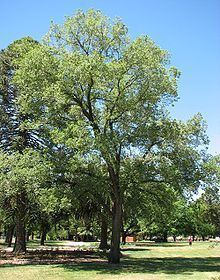Cultivar 'Argenteo-Variegata' | ||
 | ||
Similar Ulmus 'Purpurea', Ulmus parvifolia 'King's Ch, Ulmus minor 'Pendula', Ulmus davidiana var japon | ||
The Field Elm cultivar Ulmus minor 'Argenteo-Variegata' or simply 'Variegata' is said to have been first described as 'Variegata' by Wesmael [3] in Bulletin de la Fédération des sociétés d'horticulture de Belgique 1862: 390, 1863. Augustine Henry, however, citing Loudon Arboretum et Fruticetum Britannicum 3: 1395, (1838), listed an U. nitens var. variegata cultivated in Chiswick, matching the description of 'Variegata' and dating from 1838.
Contents
Description
The tree's foliage is randomly blotched and speckled with creamy white, the colour of the leaves on the same tree ranging from almost completely cream to totally green. 'Variegata' is not to be confused with the variegated English Elm cultivar, U. minor 'Atinia Variegata', which has the broader, almost orbicular leaves of the type.
Etymology
As the blotching and margination of the foliage may appear more silver than cream, the cultivar is sometimes listed as U. minor 'Argenteo-Variegata'.
Pests and diseases
The cultivar is as susceptible to Dutch elm disease as the species.
Cultivation
In Australasia and North America, where 'Variegata' is commonly cultivated and where a number of mature specimens survive (see under Accessions), the tree is known as Silver Elm or Tartan Elm. The tree also remains in commercial cultivation in Europe.
Notable trees
A notable specimen of Variegated Field Elm grew at Leek Wootton, Warwickshire. In the Netherlands, one tree, known as the Rococo Iep (:Elm) grows at Houten, next to the old church. In Australia, several trees planted in 1897 stand in Geelong Botanic Gardens, Victoria. 'Atinia Variegata' is also found among the elms lining the Avenue of Honour at Ballarat, while approximately 50 trees grow at The Nook, Sunbury. There are two mature trees in the Royal Tasmanian Botanical Gardens, Hobart. A specimen in Portland, Oregon, has been designated a 'Heritage Tree'.
Synonymy
North America
Europe
Australasia
North America
None known.
Europe
(Widely available)
